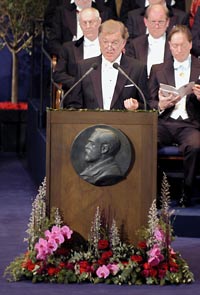Nobelpriset i fysiologi eller medicin 2004
Presentationstal av professor Sten Grillner, Karolinska Institutet, i Stockholms Konserthus 10 december 2004.
 |
| Professor Sten Grillner presenterar Nobelpriset i fysiologi eller medicin 2004 i Stockholms Konserthus. Copyright © Nobel Media AB 2004 Photo: Hans Mehlin |
Eders Majestäter, Eders kungliga högheter, Mina damer och herrar,
Vi uppfattar världen genom våra sinnen, vi ser färgprakten runt oss, vi lyssnar till vår omgivning, men vi upplever också världen genom en symfoni av olika dofter – vi kan uppfatta inte mindre än 10 000 olika lukter, här just nu inte bara blommorna från Nobels Sanremo utan också parfymer och annan väldoft. När vi snart skall njuta av kvällens middag är det främst luktsinnet som identifierar de olika kulinariska finesserna – eller värderar vinets kvaliteter. En doft från vår barndom kan få oss att återuppleva sedan länge glömda minnen, tjäran i vår barndoms fiskebåtar eller doften av kaprifol. Luktsinnet är på sätt och vis mer primitivt än andra sinnen – mindre verbalt – vi har ofta inte ord för att beskriva en ny dofts kvaliteter. Om luktsinnet skadas mister vi mycket av vår livskvalitet – livet blir gråare – maten smakar inte – men vi kan överleva. För de flesta djur är luktsinnet dock en fråga om liv och död – den lilla nyfödda ungen letar sig fram till sin mamma med hjälp av luktsinnet – utan luktsinne ingen överlevnad.
Sedan länge vet man att luktsinnescellerna sitter längst upp i näsan, och att de sänder sina tunna nervutskott genom små hål i skallbenet direkt till den del av hjärnan som kallas luktbulben. Många detaljer om hur luktsinnet är uppbyggt var också kända, men fram till den serie eleganta arbeten som Richard Axel och Linda Buck belönas för här idag förstod man inte själva grundprinciperna för hur luktsinnet fungerar. I sina studier på mus visade de, att inte mindre än drygt 3 % av musens gener används för att skapa luktreceptorer – dockningsstationer för olika luktmolekyler. De är stora molekyler som sitter inbyggda i luktcellernas cellmembran och reagerar på de olika doftämnen som passerar genom näsan. Denna stora genfamilj tillverkar drygt 1000 olika typer av dockningsstationer, som var och en reagerar på några få doftämnen. Man visade sedan att varje typ av luktreceptorcell bara har en enda typ av dockningsstation. Hos musen har man har således 1000 olika typer av luktreceptorceller. Var och en av dessa finns i ett stort antal kopior spridda i näsans slemhinna.
I will now shift over to the lingua franca of science.
The mouse thus has no less than 1000 different types of receptor cells that react to different odorants. In humans some of the genes have degenerated and we may have as little as 350 functional genes. The olfactory world of a mouse or a dog is most likely, infinitely richer than our own. Nevertheless our sense of smell adds importantly to our quality of life. Each population of receptor cells sends their processes to the same specific micro-regions in the olfactory bulb, which in turn relays the information to the next set of nerve cells. They project to the cortical regions concerned with the perception of smell. In technical terms there is a “labelled line” from each receptor subtype to the cortex, which thus will be continuously informed about the degree of activation of each of the many subtypes of receptors.
Each characteristic scent is, as a rule, a mix of odorant molecules that activates a combination of different receptor cells that send their signals via the olfactory bulb to the cortex. The specific combinatorial code that reaches the cortex makes us perceive a given scent. Richard Axel and Linda Buck have unravelled the enigma of our ability to discern so many different scents.
Professors Axel and Buck,
On behalf of the Nobel Assembly at Karolinska Institutet, I wish to convey to both of you our warmest congratulations for having unravelled the function of one of our senses, the olfactory system. You will now receive the Nobel Prize from the hands of His Majesty the King.
Nobel Prizes and laureates
Six prizes were awarded for achievements that have conferred the greatest benefit to humankind. The 14 laureates' work and discoveries range from quantum tunnelling to promoting democratic rights.
See them all presented here.
